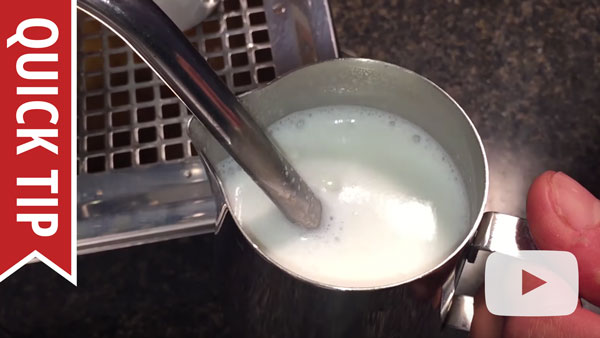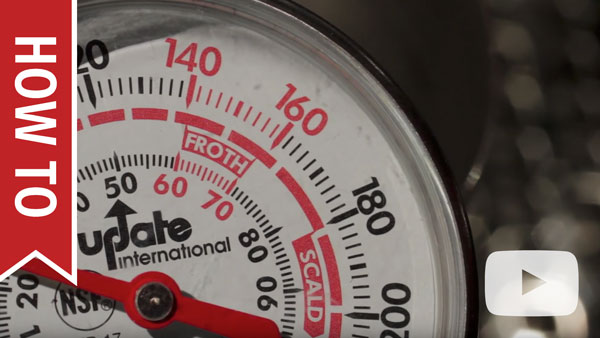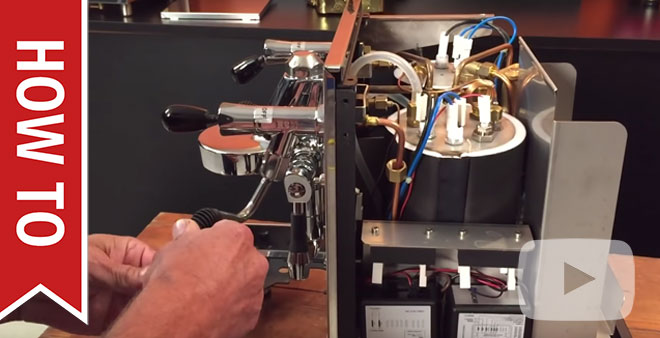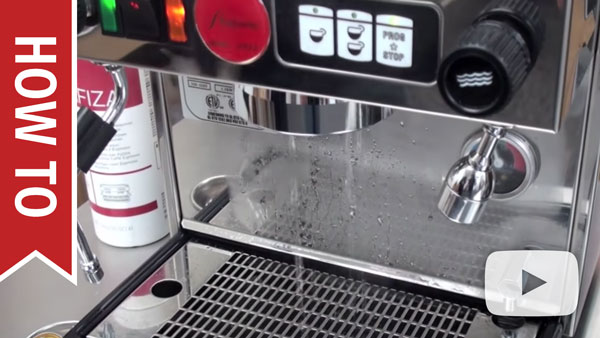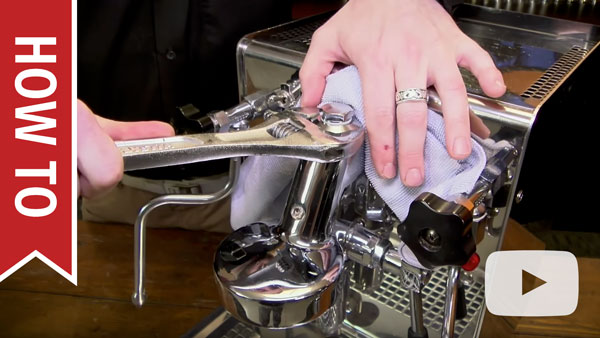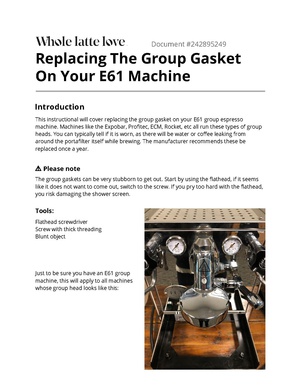Bezzera DUO DE/troubleshooting
From Whole Latte Love Support Library
No Crema or Bad Tasting Shots
Typically, issues with crema or the flavor of the shot do not indicate a malfunction of the machine. Instead, this indicates that an adjustment needs to be made in the brewing process or that different beans need to be used.
The following articles review the different variables and offer solutions:
- Tamping The Correct Way and The Effects Of Tamping Pressure
- Grinding Coffee For Espresso
- It is important to use fresh beans, typically beans roasted within the past two weeks are best. Light and medium roasts are best for espresso brewing and richer crema. Storing beans properly is also important, more information can be found here.
If the behavior persists after reviewing these factors then the machine may need to be cleaned. Lack of cleaning can cause burned or bitter flavors, or create flow issues which can result in a weak shot. Navigate to the Cleaning & Maintenance icon above for more information.
Difficulty Frothing
As with brewing, technique is critical to frothing well. Frothing is very sensitive to technique, which has a steep learning curve. If the machine is producing steam then an adjustment to technique may need to be made. The video on the right shows proper frothing technique.
Many frothing mistakes are common missteps that result in poor or no froth. The video on the right identifies these mistakes and shows how to correct them.
It is also important not to overheat your milk. The milk will have the sweetest and most velvety texture between 140-150 F°. As you froth past this point the milk will lose its sweetness, the froth will take on a gummier texture, and eventually the milk will scald and begin to taste burnt. The video on the right explains how to use a frothing thermometer so that the milk is kept within the ideal range.
Flow Issues
The first place to start with any flow issue is cleaning the machine. Before going through these steps please make sure the machine is cleaned according to the Cleaning & Maintenance section of this article.
No Steam From Wand
- Check the brew function on the machine and see if water is able to flow through the machine for this function.
- If the brew water is not flowing either refer to the No Flow At All section of this article
- If the brew water flows but is not hot refer to the On But Not Heating section of this article.
- Check the hot water function of the machine. If you are able to draw hot water then the steam boiler must be pressurizing and heating, because hot water is expelled from the machine by steam pressure. The steam pressure gauge should also read 1-1.2 Bar to indicate the boiler is pressurized.
- Remove the tip from the steam wand and test the flow. If flow is restored then the tip needs to be cleaned and reattached.
- If the flow is still blocked then there may be a blockage in the steam wand itself. Clean the wand by using a pipe brush that has synthetic or plastic bristles; metal bristles can damage the wand. Then soak the wand in a solution of hot water and backflushing powder for ten minutes. Test flow again.
- If there still isn't flow then there may be a blockage farther back in the steam circuit. The machine may need to be professionally cleaned to remove the blockage.
Poor Or No Flow From Grouphead
This machine features programmable shot timing; please check to make sure the shots are programmed properly before doing the following steps. Shots can be accidentally programmed to zero, and as a result it may seem like there is a flow issue. Try using the manual brewing function to test for flow before proceeding. If the steam/hot water for the machine is working fine then there is likely something causing a blockage or pressure issue in the brew circuit. Otherwise refer to the section of this article that discusses the machine not flowing at all.
- If a water softener is attached to the inlet line of the machine, it may be preventing water from flowing. Please remove the softener and see if the flow improves.
- The grouphead is dirty and needs to be cleaned.
- Taking apart the grouphead for manual cleaning is the first step. This should be done on a monthly basis. The instructions can be found here.
- If cleaning the grouphead restores flow to the grouphead, the machine should be immediately backflushed to prevent further flow issues.
- There might be a kinked, broken, or loose line somewhere in the machine. Remove the top of the machine and take a look inside to see if you see any obvious issues.
- There might be an issue with one of the internal valve assemblies, which may need to be cleaned or replaced.
No Hot Water From Tap
- Check the brew function on the machine and see if water is able to flow through the machine for this function.
- If the brew water is not flowing either refer to the No Flow At All section of this article
- If the brew water flows but is not hot refer to the On But Not Heating section of this article.
- Check the steam function of the machine. If you are able to draw steam then the steam boiler must be pressurizing and heating, because hot water is expelled from the machine by steam pressure. The steam pressure gauge should also read 1-1.2 Bar to indicate the boiler is pressurized.
- Remove the tip from the hot water wand and test the flow. If flow is restored then the tip needs to be cleaned and reattached.
- If the flow is still blocked then there may be a blockage in the hot water wand itself. Clean the wand by using a pipe brush that has synthetic or plastic bristles; metal bristles can damage the wand. Then soak the wand in a solution of hot water and backflushing powder for ten minutes. Test flow again.
- If there still isn't flow then there may be a blockage farther back in the hot water circuit. The machine may need to be professionally cleaned to remove the blockage.
No Flow At All
- If the pump does not sound like it is activating:
- Check to make sure the water tank is filled, and the machine isn't indicating that the water tank is empty.
- If the tank is empty, refill it.
- If the tank is full, but the machine thinks the water tank is empty, then the tank may not be seated correctly. Make sure there isn't anything blocking the tank from sitting flush inside the machine.
- Remove the cover of the machine, and check for any loose or disconnected wires.
- Make sure there aren't any kinked or pinched hoses.
- There may be an issue with the water tank sensor. Remove the cover of the machine and check the wiring to the sensor to make sure it is connected and in good condition.
- There may be an issue with the pump powering on. Check to make sure there are no loose or disconnected wires on the pump.
- Check to make sure the water tank is filled, and the machine isn't indicating that the water tank is empty.
- If the pump does sound like it is activating:
- Check the water tank to make sure it is filled and that both the inlet line and the return lines are inserted into the tank. Make sure the inlet line in particular is below the surface of the water.
- If you are using the water softener on the inlet line, try removing it and see if water can flow through the machine.
- Open up the machine. Make sure there aren't any kinked or pinched hoses anywhere.
- There may be a stuck valve inside the machine. The machine may need to be professionally repaired.
Machine Is Leaking
Between Portafilter & Grouphead
If the machine is leaking from between the grouphead and the portafilter then the grouphead gasket is either pushed out of place and needs to be reinserted properly, or the gasket is worn out. Typically, grouphead gaskets will wear out in approximately 6 months to a year depending on how heavily the machine is used. Premature wear to this gasket can be caused by using excessive force when attaching the portafilter. It is important to distinguish where the leaking is occurring. If the leaking is originating from farther up on the grouphead assembly and then draining down to where the portafilter is attached, then refer to the section of this article which discusses leaking from the grouphead.
If the leaking is coming from between the portafilter and grouphead where you twist the handle on, then the gasket will need to be replaced.
- To clean the group head first unplug the machine and remove the water reservoir.
- Place down a soft cloth or towel and tilt the machine on its back.
- Use a flathead screwdriver to remove the screw on the bottom of the grouphead. Once the screw is removed the shower screen and the diffuser plate can be removed.
- Soak the parts that were just removed in a solution of hot water and backflushing powder.
- Next the group gasket needs to be removed. The gasket on the BZ10 will have a few grooves around the perimeter. Use an awl or a small flathead screwdriver pry the gasket out; the grooves on the gasket are an easy access point to help leverage the gasket out. Gaskets that are particularly old or worn out may get stuck into the grouphead. One trick is to partially screw some self-tapping screwing into the gasket; be careful not to go too far or the screws will puncture the other side of the gasket and possibly damage the grouphead. Then use a pair of needle-nose pliers to pull on the screws. The gasket will come out with the screws.
- Once the gasket is removed use a grouphead brush or old toothbrush to scrub down the grouphead really well. Make sure to remove any built-up coffee residues or coffee grinds.
- When the grouphead is clean the new gasket can be installed. The gasket will have a tapered edge and a flat edge. The flat edge needs to fat the top of the grouphead, and the tapered edge needs to be exposed so that the it can seal with the portafilter. Press firmly all along the edges of the gasket until it is fully in place and is not sticking up anywhere along the circumference.
- Reinstall the diffuser, screen, and screw. Once everything is back together firmly attach the portafilter a few times to help the gasket seat properly, but do not over tighten. You can try using the instructions to clean and reseat the current gasket. If that does not resolve the leak then the gasket will need to be replaced.
The gasket can get stuck in the grouphead from wear or excessive heat exposure. To remove the gasket take some self-tapping screws and partially screw them into the group gasket. Make sure not to go all the way through the gasket because you can scratch/dent the grouphead if you go too far. Then use a pair of pliers to pull on the screws and the gasket will pull out with them.
From The Grouphead
If leaking is coming from the top of the grouphead, then there may be a loose component or a worn seal.
- First unplug the machine and let it cool down. The grouphead is actively heated, so sufficient time needs to be given for it to cool down in order to safely disassemble it.
- Check to see where the leaking is coming from. Page 9 of the machine's parts diagram shows a blowout view of this assembly.
- If the leaking is coming from between the upper plate (part 37) and the bottom plate (part 39), then the three allen screws may be loose, or there may be a bad gasket.
- First try tightening the three allen screws down. The allen screws are listed as part 36 on p.9 of the diagram.
- If tightening the screws does not resolve the leak then the gasket may be broken or dirty. Remove the screws; the group assembly will come off once these screws are removed, to hold the group from the bottom so it does not fall down.
- Separate the two plates; the gasket, listed as part 38 on the diagram, will be between them. Make sure it is clean and not damaged or broken. Replace the gasket if necessary.
From Bottom Of Machine
- Check the water tank and drip tray to make sure there are no cracks or breaks where water can escape. Make sure they are properly positioned on the machine.
- The machine should have both an inlet line and a return line. Make sure the return line is inside of the water tank. If you do not see the return line it may have fallen inside of the machine and will need to be retrieved and put back into the water tank.
- Open the machine and check all of the connections to make sure they are securely attached.
- Examine the pump and boiler assemblies to see if there are any cracks in them. If the machine was exposed to subfreezing conditions without being properly drained it can cause these components to crack. These parts will need to be replaced if they are cracked.
- Make sure both the inlet line and the outlet line on the pump are securely connected.
- Check the various valves located on top of the boiler assembly.
- If water is leaking from the relief valves, then the boiler may be overfilling. Distilled, reverse osmosis, and zero water are not compatible with this style of machine as the water level probe depends on minerals in the water to detect its presence. These water types do not contain minerals, and so the machine will continuously fill until it overflows, usually resulting in water leaking from the relief valves.
- If water is leaking from the relief valves even though you are using a water that contains minerals, then you may need to clean the water level probe.
- If the valves are leaking directly from where they screw into the boiler, then they may have a broken seal. Try resealing the valves by using white teflon plumbers tape or food safe permabond and screwing them back into the boiler.
- If there are any broken or cracked hoses, or hoses with pinhole leaks, they will need to be replaced.
- If you cannot find the source of the leak, it's possible the water you are seeing is from water spilled when refilling the machine, or from the drip tray being out of position. It is also possible to run the unit with the casing off to help identify the source of the leak; precautions should be taken to protect yourself from any exposed wiring or hot water or steam that comes from the machine if you attempt this.
From Steam Wand Or Hot Water Tap
- If either wand is leaking from the end of the wand, it means the steam/hot water valve is not fully closed.
- Make sure the knob is securely in the closed position.
- If the knob feels loose, or doesn't appear to be properly engaging, then there may be a loose or broken part in the knob assembly.
- Descale the machine according to the instructions in the Cleaning & Maintenance section above. Scale buildup inside of the steam/hot water valves will prevent the valves from closing fully.
- If the leaking persists, then the corresponding valve may need to be replaced.
- If the wand is leaking between the tip and the arm of the wand during use, there is an o-ring that is broken, missing, or out of position. Remove the tip on the wand that is leaking. Both the steam wand and hot water wand will have an o-ring between the tip and the wand. Inspect the o-ring to make sure it is clean. Replace the o-ring if it is damaged or broken. The hot water tip disassembles further. The top and bottom halves of the tip can be unscrewed. If leaking is coming from between these two halves, then the o-ring between them may need to be cleaned/replaced. A blowout of the hot water tip can be found on p.13 of the parts diagram.
- If the wand is leaking from the ball joint, then there may an o-ring that is worn out or out of position.
Machine Not Heating Or Powering On
No Power
- Make sure the machine is plugged into an appropriate power source.
- Do not use the machine on a surge protector. This machine has a high power draw, more than a typical kitchen appliance such as a refrigerator or a microwave. Surge protectors are typically not rated to handle the amperage this machine requires.
- Try using the machine on a different outlet, and make sure the machine is the only appliance plugged into that outlet.
- Make sure the power switches are functioning properly and not broken. If the machine isn't powering on try pressing and holding the power button in the on position to see if the machine turns on. If you are able to power the machine on this way then the power switch needs to be replaced.
- If the machine recently had a leak, had water spilled on it, or any other exposure to moisture then the machine may be shorting out. Try letting the machine sit unplugged for 48 hours to make sure there isn't a short caused by moisture.
Brew Not Heating
- Give the machine sufficient time to heat up. A heating time of 20-30 minutes is recommended for prosumer style machines for it to be sufficiently heated for brewing. Make sure the portafilter is attached during heating.
- Make sure the heating indicator is on. If the heating indicator is not on, then the machine will not heat. Typically this light will be off if the machine is out of water or not able to fill the boiler.
- The pressurestat may be set too low resulting in a lower temperature. Be cautious when adjusting the pressurestat. Setting it too high can cause the machine to overheat, resulting in the pressure relief valve blowing off excess steam.
- Unplug the machine and remove the machine case.
- Once the case is removed locate the Mater pressurestat, which will be located behind the boiler on the left hand side of the machine.
- The adjustment screw for the pressurestat is located on the top. To adjust the pressure turn the screw a quarter of a turn at a time, a small adjustment will make a large change in steam pressure and brew temperature. Clockwise will raise the pressure, counter-clockwise will lower it. Bear in mind that on this machine the steam pressure and brew temperature are correlated, and one can't be changed without affecting the other.
- The high limit switch may be tripped and needs to be reset. Instructions for resetting the high limit switch can be found in this document.
- The heating element may be broken and may require replacement.
Steam Not Heating
- If the machine is producing steam, but you think it's not producing enough steam, make sure that you are purging the line before frothing. To purge the line simply open the steam knob and let steam come through until it changes from mostly water to mostly steam. When steam leaves the boiler and hits the cold wand it is going to condense back into water. If you do not purge the line it will affect the way the steam wand froths.
- Make sure the steam boiler is turned on for the machine. Most prosumer units feature a switch, button, or PID menu option to turn the steam boiler off.
- Give the machine sufficient time to heat up. A heating time of 20-30 minutes is recommended for prosumer style machines for it to be sufficiently heated for brewing. Make sure the portafilter is attached during heating.
- Make sure the heating indicator is on. If the heating indicator is not on, then the machine will not heat. Typically this light will be off if the machine is out of water or not able to fill the boiler.
- The pressurestat may be set too low resulting in a lower brew temperature. Be cautious when adjusting the pressurestat. Setting it too high can cause the machine to overheat, resulting in the pressure relief valve blowing off excess steam.
- Unplug the machine and remove the machine case.
- Once the case is removed locate the Mater pressurestat, which will be located behind the boiler on the left hand side of the machine.
- The adjustment screw for the pressurestat is located on the top. To adjust the pressure turn the screw a quarter of a turn at a time, a small adjustment will make a large change in steam pressure and brew temperature. Clockwise will raise the pressure, counter-clockwise will lower it. Bear in mind that on this machine the steam pressure and brew temperature are correlated, and one can't be changed without affecting the other.
- The high limit switch may be tripped and needs to be reset. Instructions for resetting the high limit switch can be found in this document.
- The heating element may be broken and may require replacement.
On But Not Heating
- There is a loose, disconnected, or broken wire inside the machine. Remove the top of the machine and inspect the wiring.
- The high limit switch of the machine may have tripped. Instructions for resetting the high limit switch can be found in this document.
- The outlet the machine is plugged into is not rated to handle the power draw of the machine.
Portafilter Handle Not Fitting On Machine
- On all new machines, the portafilter may or may not fit perpendicular to the machine. This is perfectly normal. This is because the grouphead gasket requires time to wear in before this can happen. As long as you can get the portafilter hand tight onto the machine and brew without leaking, then the machine is operating properly.
- Too much coffee may be dosed into the portafilter. If there is too much coffee in the portafilter, it can press into the shower screen and prevent the portafilter tightening all the way. Reduce the amount of coffee in the portafilter and try again. If you see an indentation from the shower screen in the grounds, then you’ve added too much.
- Check the filter baskets for dings, dents, or any sort of warping. A filter basket that is malformed can prevent the filter basket from sealing up against the group gasket.
- The group gasket has slipped out of place or needs replacing. Please refer to the section of this article which discusses gasket issues for instructions on how to test the gasket or replace it.
